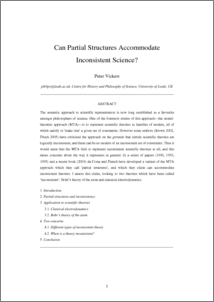Vickers, Peter
(2009)
Can Partial Structures Accommodate Inconsistent Science?
[Preprint]
![[img]](https://philsci-archive.pitt.edu/style/images/fileicons/application_pdf.png)  Preview |
|
PDF
Can_Partial_Structures_Accommodate_Inconsistent_Science.pdf
Download (135kB)
|
Abstract
The semantic approach to scientific representation is now long established as a favourite amongst philosophers of science. One of the foremost strains of this approach—the model-theoretic approach (MTA)—is to represent scientific theories as families of models, all of which satisfy or 'make true' a given set of constraints. However some authors (Brown 2002, Frisch 2005) have criticised the approach on the grounds that certain scientific theories are logically inconsistent, and there can be no models of an inconsistent set of constraints. Thus it would seem that the MTA fails to represent inconsistent scientific theories at all, and this raises concerns about the way it represents in general. In a series of papers (1990, 1993, 1995) and a recent book (2003) da Costa and French have developed a variant of the MTA approach which they call 'partial structures', and which they claim can accommodate inconsistent theories. I assess this claim, looking to two theories which have been called ‘inconsistent’: Bohr’s theory of the atom and classical electrodynamics.
Monthly Views for the past 3 years
Monthly Downloads for the past 3 years
Plum Analytics
Actions (login required)
 |
View Item |



